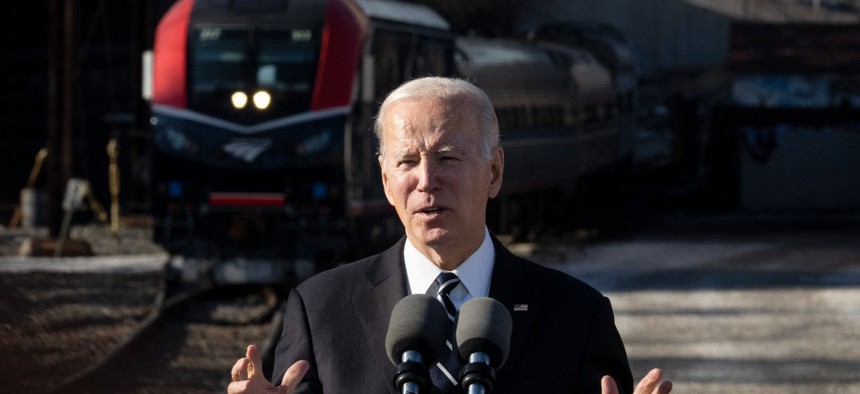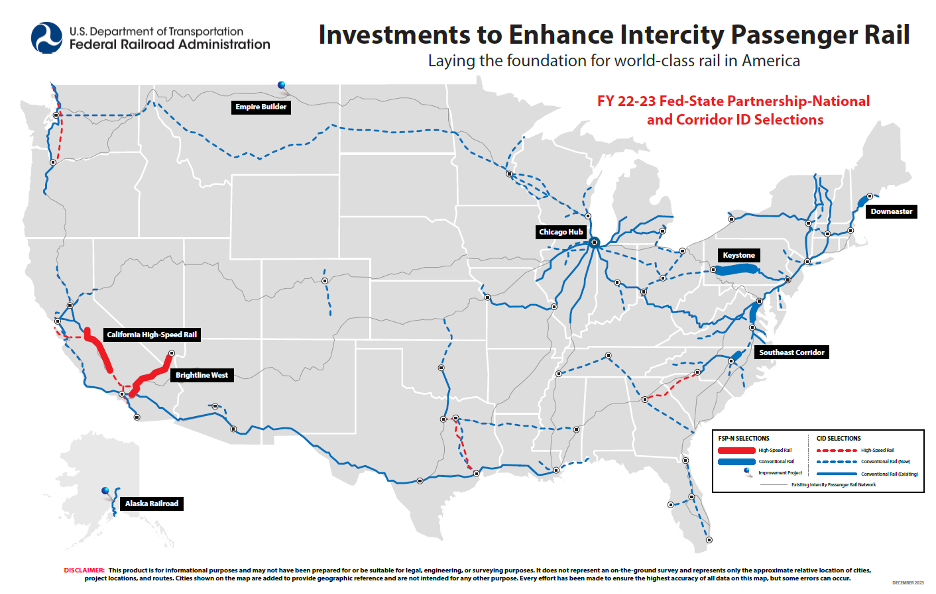Biden to invest $8B toward vision for nationwide expansion of passenger rail
The long-awaited grants for construction and planning show that the administration is unfazed by attacks in Washington over the popularity of passenger rail, with nearly every state receiving money.
President Joe Biden, known for decades as the U.S. Senate’s most loyal Amtrak passenger, unveiled his administration’s vision for a more robust passenger rail network throughout the country, with more than $8 billion in funding for big-ticket projects and grants for better service in nearly every state.
The president traveled to the crucial swing state of Nevada to announce the awards Friday, highlighting a $3 billion grant his administration is giving to help a private company build a line between Las Vegas and the suburbs of Los Angeles where trains are expected to travel 186 mph. Proponents hope the new line will be in service by the time L.A. hosts the 2028 Summer Olympics. That and other large awards for the California high-speed rail project in the Central Valley and a new line between North Carolina and Virginia had already become public earlier this week.
But these new awards cover a much broader swath of projects across the country. The administration will spend nearly $94 million to add capacity to Chicago’s Union Station, $143 million to improve service between Pittsburgh and Harrisburg in Pennsylvania, $27 million to upgrade tracks used by Maine’s Downeaster Amtrak route and $15 million to eliminate bottlenecks in Montana. Virginia is in line to receive another $729 million to add more capacity between Richmond and Washington, D.C., including a new rail bridge over the Potomac River.
The administration is also trying to lay the groundwork for future passenger rail upgrades. The Federal Railroad Administration is giving half a million dollars each to 69 projects in 44 states to help with planning for service expansions.
“President Biden’s bipartisan infrastructure law gave us a once-in-a-generation opportunity to think smart and think big about the future of rail in America, and we are taking full advantage of the resources we have to advance world-class passenger rail services nationwide,” said FRA Administrator Amit Bose in a statement.
The long-anticipated selections show that the White House is unfazed by Republican attacks in Washington that argue that the administration is spending too much money on a service so few Americans use. Biden officials enthusiastically backed the California high-speed rail project that House Republicans, particularly former Speaker Kevin McCarthy of California, have long criticized (and that Democratic Gov. Gavin Newsom of California has been uncharacteristically quiet about). The administration’s picks also show widespread support for rail projects. The grants are going to a diverse set of communities that have been asking for better rail service, from Fairbanks, Alaska, to Tampa, Florida.
The so-called Corridor ID program’s planning grants include proposals to upgrade 15 existing rail routes, add or extend service on 47 new routes and develop seven new high-speed rail projects, according to the administration. The other high-speed rail routes include a plan to connect Vancouver, Canada, with Seattle and Portland, Oregon, along with a separate proposal to link Charlotte, North Carolina, with downtown Atlanta and the Hartsfield-Jackson Atlanta International Airport.
“While it includes less money, the Corridor ID announcements may ultimately play a greater role in shaping the future of the U.S. rail network,” said Jim Mathews, president and CEO of the Rail Passengers Association, in a statement. “These grants will speed the development of new services on routes that haven’t performed the required permitting or done sufficient design and engineering work to start construction.”
“A successful federal passenger rail program must do more than improve the commutes in coastal cities,” he added. “Investing in an improved and expanded Amtrak is the surest way to ensure that the bipartisan infrastructure law improves the transportation network for all Americans."
Some of the ideas—like restoring service through the southern tier of Montana—have been talked about for decades. Colorado is getting money to plan service along the Front Range, linking many of its major cities, a big priority for Democratic Gov. Jared Polis. Louisiana wants to bring back service between Baton Rouge and New Orleans, with the prospect that Amtrak Gulf Coast service between New Orleans and Mobile, Alabama, could soon be restored.
But some projects are less defined. Texas is getting several grants for potentially overlapping service among its biggest cities, which will allow planners to consider options such as high-speed rail, a new conventional route or expansion of existing Amtrak service. “When it comes to Texas, the range of applications we selected were based on the options that we wanted Texas to have,” Bose told reporters.
The logistical hurdles for many of the projects could be high. Unlike both of the California high-speed rail projects, most of the ideas for new service would require running passenger trains on existing freight rail tracks. Many segments aren’t ready to handle higher-speed passenger trains, and freight rail companies have often resisted efforts to put more passenger traffic on their network that could interfere with their core operations. (Federal law requires that freight companies must allow passenger traffic, but conflicts over access have been common.)
Biden administration officials seemed unfazed by the historical struggles to build new passenger rail, though, particularly in California. A state-run project to connect Los Angeles to San Francisco with trains running 220 mph has far exceeded its original timelines and budgets, even as construction has been largely limited to the Central Valley, away from population centers and mountainous terrain.
“To make the cut in this round of funding, each project had to go through an extraordinary level of scrutiny,” Transportation Secretary Pete Buttigieg said. “For all of these projects, we would not be funding them if we didn’t believe that they can deliver. But we’re also going to be staying very closely engaged to make sure that they stay on time, on task and on budget.”
The transportation secretary also downplayed the likelihood that states might pull out of the funding agreements, as several Republican governors did under the Obama administration’s 2009 stimulus package. GOP leaders in Florida, Ohio and Wisconsin backed out of grants pursued by their Democratic predecessors during the Great Recession, arguing that the projects were wasteful. Their federal grant money was redirected to places like California and Illinois instead.
This time, Buttigieg said, the FRA looked for local buy-in to projects it was considering. But he acknowledged it was possible that states would return their money to Washington. Florida, for example, recently decided to forego $320 million in a separate program that provided money for carbon reduction on roads, highways and bridges.
“They’d rather just not have the funding. That’s their choice,” Buttigieg said. “Obviously, I think it’s unfortunate that Floridians will miss out on the transportation improvements that those dollars would have funded. But that can happen. That’s not really something that we expect to see here.”
As an indication that the FRA is gauging public support for projects, one Western project often touted by rail advocates in the region did not make the cut for planning money. A proposed route to connect Boise, Idaho, with Salt Lake City and Las Vegas was left off the list.
“The vast majority of proposals receiving funding have been preceded by years of grassroots organizing that ultimately culminated in the proposal,” wrote Mike Christensen, the executive director of the Utah Rail Passengers Association. “While cities in Idaho—especially Boise and Pocatello—have shown enthusiasm for returning trains to their communities, support from officials in Utah and Nevada has been lukewarm at best.”
“It appears the federal government decided to fund planning in communities whose elected officials actually want more passenger rail,” he added, “rather than in Utah.”
Daniel C. Vock is a senior reporter for Route Fifty based in Washington, D.C.
NEXT STORY: OMB adds metrics to digital experience oversight







